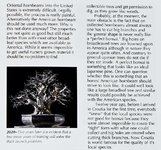Walter Pall
Masterpiece
I wrote a article about Oriental hornbeams for the very recent issue of International Bonsai. Here some paragraphs about the American hornbeam.
You are fine with the ones you have found. There must be hundreds more. Do not worry about big cuts. They do not have to close . This is just an invention of bonsai nurseries who want to sell their own stuff.View attachment 336770
You are fine with the ones you have found. There must be hundreds more. Do not worry about big cuts. They do not have to close . This is just an invention of bonsai nurseries who want to sell their own stuff.View attachment 336770

















